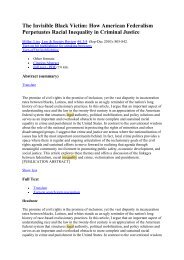Ski – resort and regional development: profile of visitors ... - E-Journal
Ski – resort and regional development: profile of visitors ... - E-Journal
Ski – resort and regional development: profile of visitors ... - E-Journal
You also want an ePaper? Increase the reach of your titles
YUMPU automatically turns print PDFs into web optimized ePapers that Google loves.
90<br />
Onome Daniel Awaritefe<br />
differed significantly between tourists <strong>of</strong> some socio-economic groups. For instance, two pairs<br />
<strong>of</strong> socio-economic groups, the middle class <strong>and</strong> working class, have means that differ<br />
significantly from each other in seven distraction/problems encountered in the tourism<br />
destinations. In Table 3, the problems <strong>of</strong> high cost, poor quality/variety <strong>of</strong> facilities <strong>and</strong> poor<br />
variety <strong>of</strong> attractions <strong>and</strong> dirty/obsolete environmental features in the destinations were<br />
considered as <strong>of</strong> overwhelmingly high concern to middle class tourists. The problems <strong>of</strong><br />
insecurity/hostility, transportation, lack <strong>of</strong> information, poor service <strong>and</strong> poor food quality<br />
were highly indicated by working class tourists. They also indicated foremost concern with<br />
problems as poor variety/poor quality <strong>of</strong> facilities <strong>and</strong> inadequate animal variety. The student<br />
tourists expressed encounter with a broader range <strong>of</strong> problems that appeared <strong>of</strong> parallel<br />
seriousness to them. Foremost amongst these are high costs <strong>of</strong> tourism items, dilapidated<br />
environments <strong>and</strong> structures <strong>and</strong> transportation problem. Table 3 also shows that education<br />
significantly influenced the tourists in their assessment <strong>of</strong> six distractions/problems they<br />
encountered in various destinations. Multiple range test applied to data in Table 3, using<br />
Scheffe’s technique, showed that there is only one pair <strong>of</strong> group <strong>of</strong> tourists whose means differ<br />
significantly from each other: Degree holders <strong>and</strong> diploma/certificate holders. Tourists with<br />
Diploma/Certificate expressed over-whelming high concern for distractions/problems associated<br />
with poor quality/variety <strong>of</strong> facilities <strong>and</strong> inadequate animal variety. Transportation was at<br />
the core <strong>of</strong> these problems. On the other h<strong>and</strong>, tourists who are degree holders indicated<br />
encountering a wider range <strong>of</strong> distractions/problems, especially associated with poor maintenance<br />
culture <strong>of</strong> tourism environments/facilities, poor quality/variety <strong>of</strong> attractions, poor<br />
management/poor services <strong>and</strong> bad food.<br />
Various t-tests applied to the data in Table 4 also shows that tourist differed significantly in<br />
their choice <strong>of</strong> tourism destination features on the basis <strong>of</strong> their sex gender. Table 4 shows<br />
that female tourists expressed significant higher choice for destinations that are distantly<br />
located/safe from their residential/work environments. This is apparently to escape from daily<br />
routine, <strong>and</strong> enjoy new <strong>and</strong> different environments. The females also showed significant higher<br />
dem<strong>and</strong> for natural, beautiful, quiet areas <strong>of</strong> unique flora <strong>and</strong> fauna, especially beaches/river/water<br />
areas <strong>and</strong> parks/games reserve with entertainment/leisure resources. In contrast, male tourists<br />
expressed significant higher dem<strong>and</strong> for unique geophysical mountainous /hilly l<strong>and</strong>form<br />
features <strong>and</strong> game reserves/parks, natural places <strong>of</strong> plenty flora <strong>and</strong> fauna <strong>and</strong> sporting<br />
facilities/events. Water/beach areas, cultural/educational <strong>and</strong> other l<strong>and</strong>form areas <strong>of</strong>fering<br />
opportunity for unique experiences constituted the major spur in choice <strong>of</strong> destination product<br />
by male tourists. Additionally, sports/recreational facilities available <strong>and</strong> their nearness to<br />
residence were also significant considerations amongst male tourists in product choice <strong>and</strong><br />
dem<strong>and</strong>.<br />
The result <strong>of</strong> the analysis presented <strong>and</strong> discussed above pertained to all the seven tourism<br />
centers <strong>of</strong> Jos, Obudu Ranch, Benin City, Yankari Games Reserve, Kainji tourism center,<br />
Badagry Beach <strong>and</strong> Abraka River tourism destinations jointly. Next, we shall establish whether<br />
significant differences exists in tourism product dem<strong>and</strong> between the tourists groups within<br />
each <strong>of</strong> the 7 destinations selected for study.<br />
Tourism Today - Fall 2007 - Full Paper














